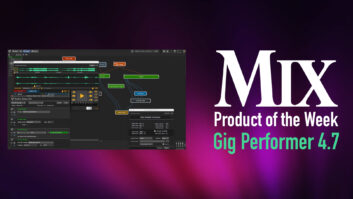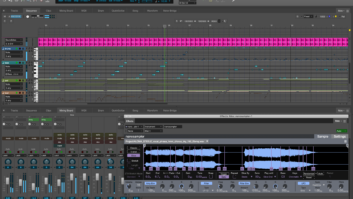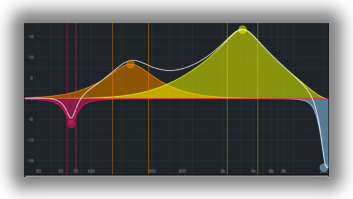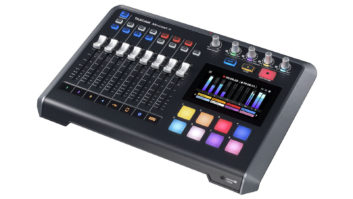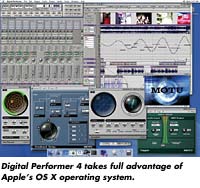
Mark of the Unicorn’s Digital Performer is based on a very robustand full-featured MIDI sequencer that has become much moresophisticated during the years, letting users record, play andmanipulate MIDI data in numerous and tremendously creative ways.Digital Performer’s audio component allows for recording, editing andmixing as many audio tracks as your CPU bandwidth allows. The newestupgrade, Digital Performer 4, was introduced last January.
NEW IN VERSION 4
The big news with DP 4 is Macintosh OS X compatibility. The totalrevamp of Apple’s operating system, not to mention its hardware,required developers to drastically alter, if not completely rewrite,programs to port them over to the platform. DP 4 fully capitalizes onCoreAudio and is optimized for multiprocessor Macs. Similarly, it takesfull advantage of CoreMIDI, which unifies MIDI for all applications andinterfaces on your Mac. The bottom line is, OS X simply makeseverything compatible and DP 4 grants you access to all of thispower.
DP 4 also adds track freezing, which allows you to render any giventrack on a temporary basis to save CPU overhead and easily“thaw” the track to make changes as you see fit —another clever convention to help the application use the computerefficiently.
If you’re like me and you’ve spent countless hours configuringFreeMIDI to reflect all of the subtle nuances in your MIDI rig, thenyou don’t want to have to start all over. DP 4 takes advantage ofCoreMIDI’s new XML patchlist format by installing hundreds of factorydefault patch lists and drum note name lists. All of the patch namelists that were represented in FreeMIDI are still here, along withquite a number of new devices. Your original FreeMIDI setup is veryeasily remapped to CoreMIDI, as well. Interapplication MIDI is also asnap with DP 4’s ability to publish an unlimited number of MIDIconnections with other applications. The setup of MIDI and audio I/Obetween DP 4 and Reason is truly effortless now, thanks to ReWire 2.0support. As much as I love the “virtual synth rack” ofReason, I’m not that keen on its sequencer. I simply use Reason like arack of physical hardware in my studio, driven by DP 4.
Digital Performer 4 features a revamped menu structure, includingnew Project and Studio menu headings. As a seasoned DP user, I wasthrown a bit at first, but ultimately became very comfortable. TheProject window contains commands that pertain to the way the project ishandled, including the ability to add tracks to the project and arrangeDP’s traditional Clippings and Consoles windows. New to Version 3, butworth mentioning here, are that the establishment and modification oftrack groups come under a major menu item. In the Studio menu, I foundmost of the stuff I used to find in the Basics menu. This menu containscommands for opening windows, specifically, the ones that pertain tothe layout of DP’s “virtual studio,” including audio andMIDI monitoring, the eminently important Audio Bundles window, and MIDIrecording-oriented items like Click and MIDI Patch Thru. The divisionof commands between these two new menus does indeed make more sense.DP’s QuickScribe notation system has some very nice enhancements andcreates very readable notation.
Last July, MOTU announced an online update from DP 4 to 4.1. Thisrevision added some pretty stupendous features. First and foremost isDAE support, enabling DP 4.1 to serve as a front end for Pro Toolssystems, including Mix, HD and HD Accel systems at up to 192kHz samplerate. This is quite significant, because it enables the marriage of DP4’s high-powered MIDI with the high-powered audio of Pro Tools.
The second major feature in 4.1 is Audio Units support for both DSPand virtual instruments. Love it or hate it, AU is the wave of thefuture, and you will use it. It’s worthwhile because AU is much moreefficient and enables cross-application use of plug-ins. For those ofyou who, like me, have come to rely heavily on certain“vintage” plug-ins, a VST-to-Audio-Unit-Adapter plug-infrom FXpansion allows you to load carbonized plug-ins in DP 4. Arelated new feature of 4.1 is virtual instrument tracks. You can add aninstrument track from the Add Tracks menu, enabling the usage of AU andMAS virtual instruments. This supercedes the traditional method of“inserting” the instrument in an audio track.
Among more pedestrian (but very useful) features in 4.1 are DocumentTemplate and Recent Document. The template facilitates the setup andstorage of frequently used audio/MIDI configurations. When creating anew project, it’s nice to be able to immediately and easily have theproject configured the way I like to work. The recent document featurepresents the 10 most recent projects in the File menu. Shift to Markerand Snap to Marker are two other handy new features. Any selectedmaterial can be “shifted” to any user-defined marker.Likewise, dragged objects can be made to “snap” to thenearest marker.
I love 4.1’s input/output display feature in the Mixing Board windowbecause I can choose to have any mixer channel’s I/O displayed belowthe track name. I have no idea why anyone would ever turn this off. Asan analogy, on an analog console, I can look to see which buttons aredepressed in the input section, output matrix or busing. Making thisI/O visible is a natural and obvious enhancement to a virtualinterface. One final new feature is enhanced OMF file import andexport. Compatibility with Pro Tools is important and MOTU takes itseriously.
Version 4.11 adds some notable features. First, Panther (OS X 10.3)compatibility has been added. Also, a new utility simplifiesconfiguration and the use of patch names for expansion cards inhardware synths. Pro Tools hardware users can now see TDM plug-inpresets in categorized submenus. Hardware drivers have been upgradedwith some significant enhancements: Users can rename inputs and outputsat the machine level so that no matter which software front end isused, the I/O names will appear as named by the user. Additionally,this update enables the usage of any pair of inputs or outputs forMacintosh system sound, including iTunes, iMovie or QuickTime.Moreover, multiple MOTU FireWire interfaces can now be resolved witheach other in terms of synchronization without external word clockconnections. This update also allows one or more MOTU audio FireWireinterfaces to resolve to third-party CoreAudio-compatible hardware.
IN SESSION WITH DP
I chose a handful of different projects to test-drive DP 4,including a vocal overdubbing session, a significantly large stereomusic mix and a moderately large 5.1 mix. I also spent quite a bit oftime just tinkering with the application’s various features,particularly with Audio Units synthesizers and plug-ins. Part of thisfield test happened on a dual-processor 1GHz G4 with 1 GB of RAM. Myinterface is an original MOTU 828. Later in the review process, I useda dual 2GHz G5 (see sidebar). All of MOTU’s drivers are current upthrough Panther (OS 10.3).
My vocal session comprised an ORTF recording of three vocalists,with doubling and tripling of some parts. The DP 4 interface isintuitive, which made the session simple to set up. I had a stereobounce of the music tracks, and I initially set up the tracks for thevocals with a reverb send. I used MOTU’s eVerb reverb plug-in, whichsounded quite nice. At one point, it became apparent that I would needmore tracks, and it was simple to add them to the session, configurethe I/O and set up auxiliaries. One particularly hip capability herewas that I was actually able to pull off some comp editing during thesession.
I wanted to push the envelope of the system with a large stereo mixand so I pulled out some tracks my friend gave me to mix. There were atotal of 35 mono tracks and one stereo track (a vocal comp). I hadcompression and 4-band EQ on most tracks, MOTU’s Pre-Amp-1 distortionplug-in on four guitar tracks and two reverbs. This required a bit morethan half of my CPU’s overhead. I’ve never been this spoiled withnative processing horsepower.
My surround mix had 28 mono tracks, quite a bit of dynamics and EQ,and three reverbs. Mixing this in 5.1 with DP 3 (and, admittedly, on asingle-processor 400MHz G4) was very taxing. In DP 4.11 on the dual1GHz G4, I still had overhead to spare. DP’s surround panning schemesstill remain among its most appealing features.
I toyed with a ReWire-connected session using Reason 2.5 and had nodifficulties driving numerous synthesizers, samplers and drum machineswith DP’s sequencer. Digital Performer 4’s mixing capabilities farsurpass those of Reason, and I love working this way. I also spent timewith MOTU’s powerful MachFive sampler, which really goes hand-in-handwith DP. MachFive is comprehensively universal, namely by virtue of itscompatibility with Mac and PC and all major Mac plug-in formats,including Audio Units, VST, RTAS, HTDM and, of course, MAS. MachFiveimports all major audio file, sample and soundbank types, includingthose from Akai, Kurzweil, Roland, E-mu and CreamWare, as well as Giga,SampleCell, EXS24, .WAV, ACID, .AIFF, SDII, REX and others. MachFivealso includes UVI-Xtract, a utility that enables extraction of patchesand samples from virtually every major format, even if the CD-ROM isnot normally mountable on the Mac desktop. Another major feature thatstands out is MachFive’s ability to handle 5.1 samples. I was able toeasily make things happen quickly with MachFive. I also downloaded theCrystal freeware AU synth from Green Oak, and it integratedsuccessfully into DP.
THE SKINNY
Digital Performer 4.11 ($795 new; $395 crossgrade; $149 upgrade) isa powerful, mature application that very efficiently capitalizes on thehuge forward strides of the latest Apple hardware and operating system.Its audio tracking, editing and mixing conventions are on par with orexceed those of any other application available today, particularly inthe surround domain. If the audio capabilities were separated from theMIDI (which, in fact, they are in MOTU’s Audio Desk) the result is anapplication that rivals any other audio-only tracking/editing/mixingsuite available. Likewise, the MIDI component of DP 4 alone is reasonenough to laud this product. Due to its lineage, DP 4 stands at the topof the MIDI sequencing world. It’s an excellent creative tool forcomposers who need a comprehensive MIDI sequencer and high-qualityaudio capabilities wrapped together — a quantum leap in theevolution of this great audio production tool.
Mark of the Unicorn, 617/576-3066, www.motu.com.
John McJunkin is the principal of Avalon Audio Services(Phoenix).
THE G5 TEST
I test-drove DP 4 on a dual 2.0GHz G5, and wow! MOTU has always beenat the bleeding edge to optimize its products for new computers and theG5 is no exception. I developed a sequence using MOTU’s MachFivesampler. Using two iterations, I had nine polyphonic instruments up andrunning, with polyphony occasionally spilling over 100 notessimultaneously. There was also a stereo drum loop, and the mix includedsix reverbs, four resonant filters, three phasers, two delays, twochoruses, one EQ and MOTU’s powerful MasterWorks multiband compression.My performance meter showed less than 50-percent CPU headroom in use.More importantly, operation was glass-smooth, with not even so much asa hiccup. It’s safe to say that native DAWs have caught up with thecapabilities of the hardware-oriented DAWs.
— John McJunkin
